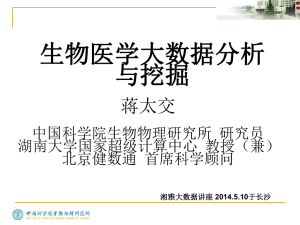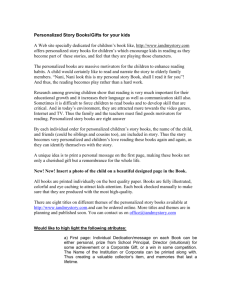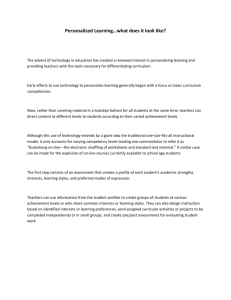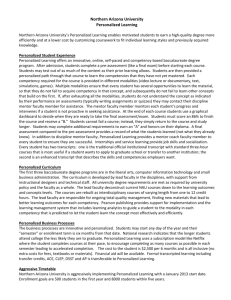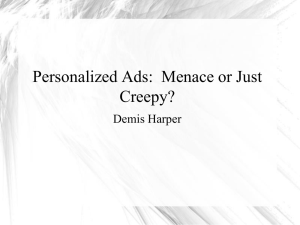EFFECT OF PERSONALIZED PRICE ON DECISION MAKING
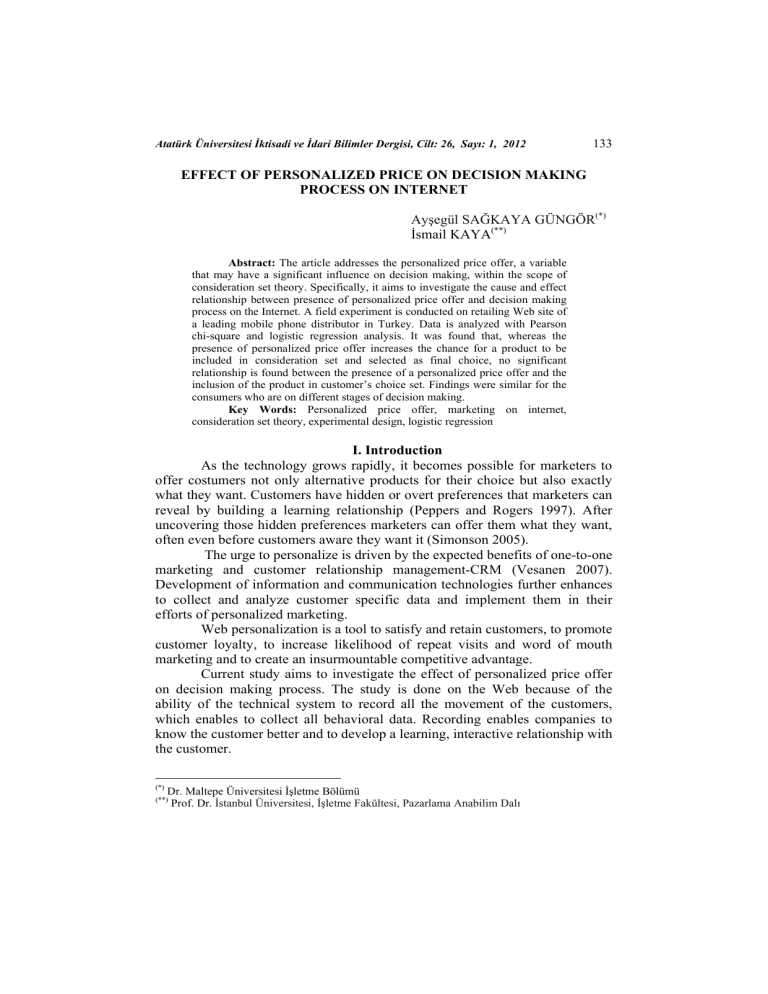
Atatürk Üniversitesi İ ktisadi ve İ dari Bilimler Dergisi, Cilt: 26, Say ı : 1, 2012 133
EFFECT OF PERSONALIZED PRICE ON DECISION MAKING
PROCESS ON INTERNET
Ay ş egül SA Ğ KAYA GÜNGÖR
İ smail KAYA (**)
(*)
Abstract: The article addresses the personalized price offer, a variable that may have a significant influence on decision making, within the scope of consideration set theory. Specifically, it aims to investigate the cause and effect relationship between presence of personalized price offer and decision making process on the Internet. A field experiment is conducted on retailing Web site of a leading mobile phone distributor in Turkey. Data is analyzed with Pearson chi-square and logistic regression analysis. It was found that, whereas the presence of personalized price offer increases the chance for a product to be included in consideration set and selected as final choice, no significant relationship is found between the presence of a personalized price offer and the inclusion of the product in customer’s choice set. Findings were similar for the consumers who are on different stages of decision making.
Key Words:
Personalized price offer, marketing on internet, consideration set theory, experimental design, logistic regression
I. Introduction
As the technology grows rapidly, it becomes possible for marketers to offer costumers not only alternative products for their choice but also exactly what they want. Customers have hidden or overt preferences that marketers can reveal by building a learning relationship (Peppers and Rogers 1997). After uncovering those hidden preferences marketers can offer them what they want, often even before customers aware they want it (Simonson 2005).
The urge to personalize is driven by the expected benefits of one-to-one marketing and customer relationship management-CRM (Vesanen 2007).
Development of information and communication technologies further enhances to collect and analyze customer specific data and implement them in their efforts of personalized marketing.
Web personalization is a tool to satisfy and retain customers, to promote customer loyalty, to increase likelihood of repeat visits and word of mouth marketing and to create an insurmountable competitive advantage.
Current study aims to investigate the effect of personalized price offer on decision making process. The study is done on the Web because of the ability of the technical system to record all the movement of the customers, which enables to collect all behavioral data. Recording enables companies to know the customer better and to develop a learning, interactive relationship with the customer.
(*) Dr. Maltepe Üniversitesi İş letme Bölümü
(**) Prof. Dr. İ stanbul Üniversitesi, İş letme Fakültesi, Pazarlama Anabilim Dal ı
134 Ay ş egül SA Ğ KAYA GÜNGÖR, İ smail KAYA
II. Main Research Question and Importance of the Topic
In literature of personalization, some research directions were proposed for further research. One of the questions frequently asked by practitioners of web personalization leads to this research. The question is “Which specifics could be offered to influence individual customers’ consideration set?” (Murthi
& Sarkar 2003). It is proposed that one of the specifics to be offered to influence individual customers’ consideration set is “personalized price”.
This paper is motivated by the following research question: “Is personalized price offer, when compared with an ordinary discount price, more effective at decision making process”? To be effective at decision making process, for the purpose of this paper, is defined as “to enable the product in the offer to be included in the consideration set, choice set and finally to be bought”.
The study is important in three aspects: First, understanding the mechanism of decision making process of an individual customer enables online retailers to better organize their web sites. Second, inclusion of a product in the consideration set leads to purchase. A product which is not included in the consideration set, most of the time, is not eligible for purchase. Therefore, determining whether or not personalized price offer affects the inclusion of a product in the consideration set, choice set and choice is an important subject.
Third, if the effect of personalized price offer is proven, a powerful tool to be used to intervene the customers’ decision making process will be at disposal to web retailers.
The research question posed by this study is a multi-stage one. It is necessary to address the topic of the effect of personalized price offer at multiple stages. According to the literature, decision making has several stages, namely awareness, consideration, choice stage and final choice, and the effect on all these stages will be covered in the study.
III. Theoretical Perspectives and Hypothesis Development
A. Consideration Set Theory
Consideration set theory explains how consumers cope with complex purchase decision making problems. According to the theory, consumers refine the available number of alternatives successively (Roberts 1989). Refinement of alternatives is performed by forming some mental sets. These sets are hierarchical in nature, and while going over the next stage the number of product alternatives are reduced. Although theory proposes four different sets in decision making, literature shows that one additional set, choice set, could be considered as a stage, too:
Atatürk Üniversitesi İ ktisadi ve İ dari Bilimler Dergisi, Cilt: 26, Say ı : 1, 2012 135
Universal set → Awareness set → Consideration set → Choice set → Choice
Figure 1. Decision Making Stages According to Consideration Set Theory
Universal Set: The first set in the decision making process is the universal set. In a buying process, it consists of all the available alternatives that could be purchased by the customer in the market. Therefore it is the biggest among four sets. Consumers need not to be aware of all the alternatives in the market. Actually, in most of the situations, it is nearly impossible (Ratchford
1982; Shugan 1980).
Awareness Set (Retrieval set): Awareness set is the subset of the universal set. Having a limited cognitive capacity, the consumer can be aware of only limited number of products. The content of the awareness set can be influenced by a number of variables, such as expertise, processing capacity, attention, comprehension (Shocker et al 1991). According to Gruca (1989), awareness set consists of three different sets: Inept set, inert set and consideration set. Therefore, it is from the awareness set, the consideration set evolves.
Consideration Set: Purchase process is a complex problem for the consumers. Decision makers tend to simplify this complexity by dividing the available alternatives, which they are aware of, into two groups: One consists of the products that will not be considered and the other consists of the products that will be considered, forming the consideration set. Consumers limit their purchases to these alternatives (Roberts & Latin 1997). The reduction in the number of alternatives enables consumer to evaluate fewer products, leading less effort for cognitive capacity to compare (Gensch 1987; Johnson & Payne
1985; Gruca 1989; Shocker et al 1991).
While forming consideration set, there is a cost-benefit evaluation process. In order a product to be accepted to consideration set, perceived benefit obtained from considering the product should be higher than the cost associated with search activities (Hauser & Wernerfelt 1990; Roberts & Lattin 1991;
Stigler 1961). When an alternative product is included in the consideration set, even if it is not the best among alternatives, its purchase probability increases
(Andrews & Srinivasan 1995).
Consideration set has a dynamic form. As the information collection process continues, products enters and exits from the set. It also differs from person to person as well as for a person in each buying situation.
When information collection about the products comes to an end, a new, static set is formed called choice set.
136 Ay ş egül SA Ğ KAYA GÜNGÖR, İ smail KAYA
Choice Set: Although consideration set has a dynamic form, choice set is static. It consists of products, one of which will be purchased. The content of the choice set is influenced by a number of variables, such as product importance and educational level (Gruca 1989).
Although there are many variables studied which affect the consideration set size and/or content in the previous studies, such as time pressure (Gronhaug 1973; Shugan 1980), advertising (Coates & Butler & Berry
2004; Chang 1998; Mitra & Lynch 1995; Kumar 1997), brand loyalty (Sheth
1968), perception of risk (Gronhaug 1973), the question of new variables which affects individual customer still remains. This study proposes a new variable:
Personalized Price Offer
B. A Variable That Affects the Decision Making Process:
Personalized Price Offer
“Customers, whether consumers or businesses, do not want more choices. They want exactly what they want –when, where and how they want it- and technology now makes it possible for companies give it to them.”
Pine, Peppers and Rogers
The literature review reveals several terms describing personalization:
In operational terms, personalization is defined as; for each customer, tailoring the product to be structurally appropriate and financially attainable.
One viewpoint on personalization is technology-based, as it was defined in Personalization Consortium (2005): “Personalization is the use of technology and customer information to tailor electronic commerce interactions between a business and each individual customer. Using information either previously obtained or provided in real-time about the customer, the exchange between the parties is altered to fit that customer’s stated needs as well as needs perceived by the business based on the available customer information”.
Commonly used to enhance customer service or e-commerce sales, personalization is sometimes referred to as one-to-one marketing ; because the product is tailored to specifically target each individual customer.
Personalization is the micro segmentation form of market segmentation. In this application, each individual consumer is a target market.
The goal in personalization is to deliver the right content to the right person in the right format at the right time.
D. Model and Hypothesis Development
The effect of personalization on decision making process is the main theme of this research. When compared with an ordinary price discount, targeting the mass market, it is expected that a personalized price offer, targeting an individual customer, should be much more effective. In the personalization case, the price was tailored based on the previous purchase
Atatürk Üniversitesi İ ktisadi ve İ dari Bilimler Dergisi, Cilt: 26, Say ı : 1, 2012 137 history of individual customer and a privilege was offered to him/her. As the customer has proven his/her loyalty to the firm, these obtained privileges would increase accordingly.
In accordance with literature, hypothesis below are proposed:
H1: Personalized price offer affects the decision making process.
H1a: The likelihood of a product to be included in the consideration set is higher in the presence of a personalized price offer.
H1b: The likelihood of a product to be included in the choice set is higher in the presence of a personalized price offer.
H1c: The likelihood of a product to be selected as final choice is higher in the presence of a personalized price offer.
The model suggested by the arguments developed above is depicted in Figure 2.
Buying Process
Personalized
Price Offer
H1a
H1 Inclusion in
Consideration
Set
Inclusion in
Choice Set
Choice
H1b
H1c
Process flow
Causal relationship
Figure 2 : Proposed Research Model and Corresponding Hypothesis
III. Research Methodology
A.Participants
The authors cooperated with a mobile phone distributor in Turkey.
Online retailing site of the distributor was used to conduct a field study. Sample
138 Ay ş egül SA Ğ KAYA GÜNGÖR, İ smail KAYA consists of the users, who purchased at least one mobile phone from the online retailing site of the distributor.
Nokia N73 and Nokia N95 1 were offered with a personalized price at the Web site, to the subjects of the experiment. It seemed to be the most appropriate brand with 59% market share at the end of year 2008, 81% brand loyalty, 82% unaided and 99% aided recall in Turkey. Accordingly, the participants of the experiment were the current users of Nokia mobile phone.
As the nature of the field study, participants were not informed about the experiment. The very natural behavior of the participants, in response to treatment, was recorded and the obtained data was analyzed.
B. Procedure
The retailing web site was divided into parts defined by the stages of the consideration set theory. As the user log on to the Web site, using his/her user name and password, it was assumed that s/he was on the awareness set formation stage. Phones viewed at the first page were assumed to be contributed to awareness set of the user. So, at this stage, awareness set was not formed, yet, but about to be formed. The first treatment was applied at this stage (Figure 3).
This stage was called the “1 st stage” in short, meaning “before awareness set formation.”
As the user navigated across the web pages, s/he was encountered with different mobile phones with no more information than price and a picture of the phone. There was “more information” link, enabling users to get detailed information about the phone, next to each mobile phone image. Furthermore, there was a “compare” link next to each image, enabling users to compare the phone with other two and an “order now” link at the same page, enabling users to purchase the phone. As s/he requested more information about, at least, two mobile phones, it was assumed that those phones were in the consideration set of the user, and the user was about to form his/her consideration set. The other treatment was applied at this stage. It was denoted as “2 nd stage” in short, meaning “before consideration set formation”. Timing of treatments is shown in
Figure 3.
The personally-priced phone was offered to the subject at one of these two stages 2 . It was the only phone at the screen and came with a heading written
1 Nokia N73 was chosen for the low segment and Nokia N95 was chosen for the middle segment of mobile phone consumers. In order to choose these two models, an investigation of log of previous purchases was conducted. As a result of investigation, four models of Nokia phones for low segment and four models of Nokia phones for middle segment were chosen. These models were evaluated with the help of a questionnaire answered by an appropriate group of people, which is different from the subjects in the study. Results of statistical tests yielded
Nokia N73 and Nokia N95 as the most appropriate for the study.
2 A subject was exposed to the treatment only once and at only one of these two stages.
Atatürk Üniversitesi İ ktisadi ve İ dari Bilimler Dergisi, Cilt: 26, Say ı : 1, 2012 139
“Based on your previous purchases, the price of the mobile phone below is personalized for you”.
Subjects were divided into two groups for each stage: Treatment group and control group. There were four groups in total. Subjects in the treatment groups were exposed to a personalized price offer. On the other hand, price offered to subjects in the control groups were expressed as an ordinary price discount. Both the treatment group and the control group received a 10% price discount, which was the suggested rate by the marketing authorities of the distributor.
It was assumed that, a subject who clicked on “more information” link included that phone in his/her consideration set. Similarly, a user who clicked on “compare” link included that phone in his/her choice set, a user who clicked on “order now” link wanted to purchase that phone. All variables were binary in nature (1= inclusion of the mobile phone in the consideration set/choice set/choice, 0=otherwise).
Universal
Set
Awareness
Set
Consideration Set Choice
Set
Choic e
TREATMENT TREATMENT
Figure 3 : Presentation of Timing of Treatment
C. Pretest
A pretest with 21 participants was conducted to test the system and the details of the personalization application. After the test was completed, it was determined to display just one offer in the screen 3 . Besides, it was ensured that phrases on the screen are persuasive enough that the offered price is personal and the criteria used to display the order were working accurately at the backend system. Moreover, it was ensured that the clicks were recorded correctly.
3 There were different views about placing just one personalized offer (supporters are Iyengar &
Lepper 2000, Dhar 1996,1997, Tversky & Shafir 1992) or more than one personalized offer
(supporters are Simonson & Tversky 1992, Huber, Payne & Puto 1982) at once.
140 Ay ş egül SA Ğ KAYA GÜNGÖR, İ smail KAYA
IV. Results of the Study
The total number of participants was 531. There were 170 woman and
361 men. Their average age was 30.72 years. Participants were randomly assigned to one of the four treatment groups. In order to be sure that treatment and control group members were similar to each other for each stage, so that the difference in the behavior could be attributed to the treatment, not to the dissimilarities of the participants, Pearson chi-square test was conducted.
According to test results, treatment and control group participants of the first stage were similar of age ( χ 2 (1)= 28.040, p>0.05), and gender ( χ 2 (1)= 0.159, p>0.05). Treatment and control group participants of the second stage were also similar of age ( χ 2 (1)= 0.059, df=1, p>0.05), and gender ( χ 2 (1)= 1.634, p>0.05).
A. Significance of Relationships
Pearson chi-square test was conducted to understand if the relationship between personalized/discount price (treatment) and the behavior at different stages of decision making is significant. According to results, when treatment was applied before awareness set formation (first stage), there was a significant relationship between the treatment and the product to be included in consideration set ( χ 2 (1)= 4.680, p=0.031) and selected as final choice ( χ 2 (1)=
5.423, p=0.02) (Table 1). However, there was no significant relationship between the product to be included in choice set and the treatment ( χ 2 (1)= 2.561, p=0.110) (Table 1).
Similar to the first stage results, at the second stage, there was a
( significant relationship between the product to be included in consideration set
χ 2 (1)= 10.953, p=0.001) and selected as final choice ( χ 2 (1)= 6.768, p=0.009) and the treatment (Table 1). However, there was no significant relationship between the product included in choice set ( χ 2 (1)= 0.042, p=0.834) and the treatment at the second stage (Table 1). Thus, H1b was not supported.
Table 1: Significance of Relationships Between Presence/Absence of
Personalized Price Offer and Product Included in Consideration Set, Choice
Set and Selected as Final Choice
1 st stage (Treatment before awareness set formation)
N= 243 (95 a +148 b )
Number of active participants
Pearson chi-square (df=1)
Consideration set
TG 1 CG 2
Choice set
TG 1 CG 2
Final choice
TG 1 CG 2
91 45 67 53 30 69
4.680 2.561 5.423
Atatürk Üniversitesi İ ktisadi ve İ dari Bilimler Dergisi, Cilt: 26, Say ı : 1, 2012 141
2 nd stage (Treatment before consideration set formation)
N= 288 (145 a +143 b )
Consideration set
TG 1 CG 2
Choice set
TG 1 CG 2
Final choice
TG 1 CG 2
Number of active participants
83 54 43 44 80 57
Pearson chi-square (df=1)
10.953 0.042 6.768
P 0.001 a Number of total participants in treatment group b Number of total participants in control group
1 TG: Treatment Group
2 CG: Control Group
B. Results of Logistic Regression Analysis
Logistic regression analysis was conducted with personalized price offer as the independent variable, explaining the change in decision making behavior. The dependent variables were the inclusion of offered mobile phone in consideration set and selection of offered mobile phone as final choice, separately. Logistic regression analyses were conducted only for variables whose relationships were proven as significant at “significance of relationships” section.
Results showed that personally-priced mobile phones were accepted to the consideration set more often than discount-priced mobile phones independent of the stage of decision making (i.e., the situation was same in both stages of treatments).
When the personalized price was offered before awareness set formation (first stage) , the chance of the product to be included in consideration set was 61%, whereas it was 47% in an ordinary discount price case ( χ 2 (1) =
4.68, p<0.05) (Table 2). There is a significant 14% increase (t=2.164, df=203.4, p<0.05), supporting H1a.
Regarding final choice, chance that the product selected as final choice was 47% when it was offered with a personally-priced price, whereas the chance dropped to 32% in an ordinary discount price case ( χ 2 (1)=5,50, p<0.05)
(Table 2). There is a significant 15% increase (t=2.345, df=190, p<0.05), supporting H1c.
Similar to the first stage results, when the personalized price was offered before consideration set formation (second stage) , chance that the product included in consideration set was 57 %, whereas it was dropped to 38% in an ordinary discount price case ( χ 2 (1) = 11.03, p<0.01) (Table 2). There is a significant 19% increase (t=3.289, df=285, p<0.01), supporting H1a once more at the second stage.
142 Ay ş egül SA Ğ KAYA GÜNGÖR, İ smail KAYA
Regarding final choice, probability that the product selected as the final choice was 55% in the presence of a personalized price, whereas it was 40% in an ordinary discount case ( χ 2 (1) = 6.80, p<0.01) (Table 2). There was a significant 15% increase (t=2.578, df=285, p<0.01), supporting H1c once more.
Table 2 : Comparison of the Probabilities of the Product Included in the
Consideration Set and Selected as Final Choice in the Presence of Personalized
1 st
Price Offer and Ordinary Discount Price
stage (Personalized price offered before awareness set formation)
Inclusion in consideration set 1 Selected as final choice 2
Logit
Odds
Probability
Personalized price (0)
Discount price
(1)
Personalized price (0)
Discount price
(1)
0.468 -0.105 -0.135 -0.773
1.599 0.900 0.874 0.462
0.61 (61%) 0.47 (47%)
Inclusion in consideration set 3
0.47 (47%)
Difference between 0.14 (14%) * probabilities
2 nd stage (Personalized price offered before consideration set formation)
0.32 (32%)
Selected as final choice 4
Logit
Odds
Probability
Personalized price (0)
Discount price
(1)
Personalized price (0)
Discount price
(1)
0.292 -0.499 0.208 -0.411
1.339 0.607 1.231 0.663
0.57 (57%) 0.38 (38%) 0.55 (55%) 0.40 (40%)
Difference between probabilities
* p<0.05 **p<0.01
1 Logit = -0.573 + 0.468x
2 Logit = -0.638 – 0.135x
3 Logit = 0.292 – 0.791x
4 Logit = 0.208 – 0.619x
0.19 (19%) *
V. Conclusion and Discussion of Results
According to the results of the study, which aims to test the effect of personalized price offers on Internet on decision making stages of consumers, personalized price offer partially affects the decision making. As a result, H1 is partially supported. Specifically, it affects the product to be included in
Atatürk Üniversitesi İ ktisadi ve İ dari Bilimler Dergisi, Cilt: 26, Say ı : 1, 2012 143 consideration set, supporting H1a, and selected as final choice, supporting H1c.
However, personalized price has no effect on a product to be included in choice set, a result which leads to rejection of H1b.
The last result can be attributed to various reasons: First of all, it is a probability that most of the mobile phone consumers does not form a choice set during mobile phone purchase. Second, choice set is not regarded as a stage in decision making process by most of the researchers. Even if there is a choice set among decision making stages, it is a probability that choice set is not formed for some kind of products. Third, the comparison of alternative mobile phones can be accomplished mentally. At this case, consumers make the comparison mentally with the information they have collected during consideration set formation stage. Thus, no physical comparison behavior can be observed.
According to results of logistic regression analysis, a price perceived personal has significantly increased the chance that a product to be included in consideration set compared to an ordinary price discount, although the same prices were offered in both cases. This is exactly the same in final choice, which means perception of personalization has a real power.
Although there are alternative personalization applications, price personalization is one of the simplest ways to achieve it. If a perception of distinctness on the consumer can be achieved, opportunity to sell the product will increase.
VI. Contributions
A. Theoretical Contributions
Although there is a widespread adoption of personalization and technology-aided marketing, a few researches have been done to assess the effectiveness of personalization in Turkey. This research aims to bridge this gap and provide an extensible theoretical framework to investigate issues further related to personalization.
In order to proceed, first of all, effect of a variable has to be proven. The current study represents one of the pioneering efforts to study the effects of personalization, more specifically effect of personalized price. Findings showed that personalized price offer effects the decision making process. Knowing price-personalization is effective variable, different aspects of personalization can be studied.
Second, this study makes use of the consideration set theory in defining decision making stages, accepting the choice set as a stage in decision making.
However, there was no relationship found with the presence of a personalized price offer and a product to be included in choice set. This result raises a question about the actual presence or product dependency of choice set.
Third, although there are many applications of consideration set theory on traditional mediums, there is not much study on the application of
144 Ay ş egül SA Ğ KAYA GÜNGÖR, İ smail KAYA consideration set theory on Internet. This study, further, contributes to the application of theory on the Internet.
B. Practical Contributions
Online retailers that contemplate the use of opportunities of being online need to understand the availability of tools to them and their effectiveness. The main benefit gained by a company with the application of personalization is the satisfaction of existing customers, which leads to enhanced customer loyalty. Positive word of mouth, better response rates, and enhancing competitive advantage are the other gaining. This work represents a systematic study to prove the effect of personalized price on rewarding existing customers. Furthermore, it sheds light on the significance of personalization for online merchants in persuading a user to consider a product.
Understanding the stages of decision making will further ease the way of online practitioners do business. Consideration set theory is applicable to most kind of decision making situations. Knowing the decision making stage of the consumer on the Web site will be helpful to influence the decision.
VII. Opportunities for Future Research
This work can be extended in a variety of ways: First, the applied design here was field experiment. Although field experiments have higher external validity, they have less internal validity compared to laboratory experiments (Churchill, 1991). In order to contribute the robustness of the results, it can be repeated in a laboratory setting.
This work has studied the effect of personalized price offers.
Personalization can be applied in many different forms such as product personalization, Web site personalization, offering different complimentary products for different customers etc. Thus, the study can be repeated with a different form of personalization.
A third opportunity for research is about the number of the products offered. In this personalized offer, there was just one mobile phone offered.
There is no chance to select between the personally-priced mobile phones.
There is a chance to conduct the study with more than one product priced personally, offered to consumer at the same time.
References
Andrews, R.L., Srinivasan, T.C. (1995), “Studying Consideration Effects in
Empirical Choice Models Using Scanner Panel Data”, Journal of
Marketing Research , 32, pp.30-41.
Chang, K. (1998), “Essays on Heterogeneity in Choice Modeling”, Unpublished
Doctoral Dissertation , The University of British Columbia.
Atatürk Üniversitesi İ ktisadi ve İ dari Bilimler Dergisi, Cilt: 26, Say ı : 1, 2012 145
Churchill, G.A., Jr. (1991). Marketing Research: Methodological Foundations.
5th ed., Orlando: The Dryden Press Int. Edt.
Coates, S.L., Butler, L.T. and Berry, D. C. (2004), “Implicit Memory: A Prime
Example for Brand Consideration and Choice”, Applied Cognitive
Psychology , 18, pp.1195–1211.
Dhar, R. (1996), “The Effect of Decision Strategy on the Decision to Defer
Choice”, Journal of Behavioral Decision Making , 9, 4, pp.265–81.
Gensch, D.H. (1987), “A Two-Stage Disaggregate Attribute Choice Model”,
Marketing Science , 6, 3, pp.223-231.
Gronhaug, K. (1973), “Some Factors Influencing the Size of the Buyer’s
Evoked Set”, European Journal of Marketing , 7, pp.232-241.
Gruca, T.S. (1989), “Determinants of Choice Set Size: An Alternative Method for Measuring Evoked Sets”, Advances in Consumer Research , 16, pp.515-521.
Hauser, J.R., Wernerfelt, B. (1990), “An Evaluation Cost Model of
Consideration Sets”, Journal of Consumer Research , 16 (March), pp.393-408.
Huber, J., Payne, J.W. and Puto, C. (1982), “Adding Asymmetrically
Dominated Alternatives: Violations of Regularity and the Similarity
Hypothesis”, Journal of Consumer Research , 9 (June), pp.90–98.
Iyengar, S.S., Lepper, M.L. (2000), “When Choice is Demotivating: Can One
Desire Too Much of a Good Thing?”, Journal of Personality and
Social Psychology , 79 (December), pp.995–1006.
Johnson, E.J., Payne, J.W. (1985), “Effort and Accuracy in Choice”,
Management Science, 31 (April), pp.395-414.
Kumar, P. (1997), “Dynamic Hierarchical Bayesian Models of Consideration and Choice- Issues and Estimation”, Unpublished Doctoral
Dissertation, State University of New York, Buffalo.
Mitra, A., Lynch, J.G. Jr. (1995), “Toward a Reconciliation of Market Power and Information Theories of Advertising Effects on Price Elasticity”,
Journal of Consumer Research , 21, 4, pp.644-659.
Murthi, B.P.S., Sarkar, S. (2003), “The Role of the Management Sciences in
Research on Personalization”, Management Science , 49, pp.1344-
1362.
Peppers, D., Rogers, M. (1997), Enterprise One-to-one: Tools for Competing in the Interactive Age. New York: Doubleday.
Personalization Consortium (2005), 2 August, available at: www.personalization.org/personalization.html (Retrieved -
2010.08.23)
Ratchford, B.T. (1982), “Cost-Benefit Models for Explaining Consumer Choice and Information Seeking Behavior”, Management Science , 28, 2, pp.197-212.
146 Ay ş egül SA Ğ KAYA GÜNGÖR, İ smail KAYA
Roberts, J. (1989), “A Grounded Model of Consideration Set Size and
Composition”, Advances in Consumer Research, 16, pp.749-757.
Roberts, J.H., Lattin, J.M. (1991), “Development and Testing of a Model of
Consideration Set Composition”, Journal of Marketing Research, 28
(November), pp.429-440.
Sheth, J.N. (1968), Perceived Risk and Diffusion of Innovations in Insigth into
Consumer Behavior , J. Arndt ed., Boston, Massachusetts: Allyn and
Bacon Inc.
Shocker, A.D., Ben-Akiva, M., Boccaro, B. and Nedungadi, P. (1991),
“Consideration Set Influences on Consumer Decision-Making and
Choice: Issues, Models and Suggestions”, Marketing Letters, 2, 3, pp.181-197.
Shugan, S.M. (1980), “The Cost of Thinking”, Journal of Consumer Research ,
7(2), pp.99-111.
Simonson, I. (2005), “Determinants of Customer Responses to Customized
Offers: Conceptual Framework and Research Propositions”, Journal of Marketing , 69, pp.32-45.
_____, Tversky, A. (1992), “Choice in Context: Tradeoff Contrast and
Extremeness Aversion”, Journal of Marketing Research , 29
(August), pp.281–96.
Stigler, G.J. (1961), “The Economics of Information”, Journal of Political
Economy , 69, 3, pp.213-225.
Tversky, A., Shafir, E. (1992), “Choice Under Conflict: The Dynamics of
Deferred Decision”, Psychological Science , 3, 6, pp.358–361.
Vesanen, J. (2007), “What is Personalization? A Conceptual Framework”,
European Journal of Marketing, 41, 5/6, pp.409-418.
